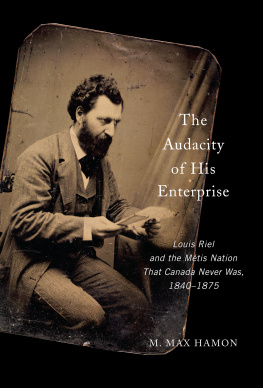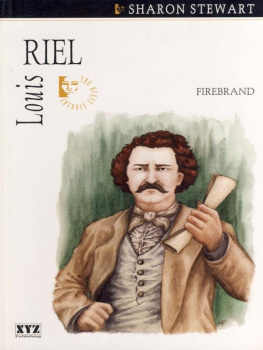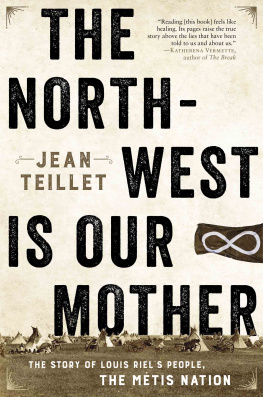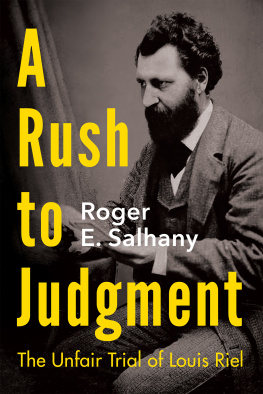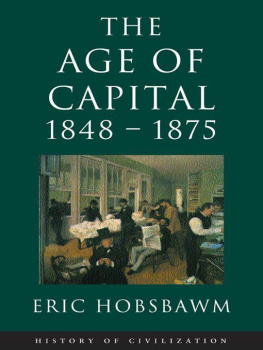
THE AUDACITY OF HIS ENTERPRISE
The Audacity of His Enterprise
Louis Riel and the Mtis Nation That Canada Never Was, 18401875
M. MAX HAMON
McGill-Queens University Press
Montreal & Kingston London Chicago
McGill-Queens University Press 2019
ISBN 978-0-7735-5937-0 (cloth)
ISBN 978-0-2280-0008-2 (ePDF)
ISBN 978-0-2280-0009-9 (ePUB)
Legal deposit fourth quarter 2019
Bibliothque nationale du Qubec
Printed in Canada on acid-free paper that is 100% ancient forest free
(100% post-consumer recycled), processed chlorine free
This book has been published with the help of a grant from the Canadian Federation for the Humanities and Social Sciences, through the Awards to Scholarly Publications Program, using funds provided by the Social Sciences and Humanities Research Council of Canada.
We acknowledge the support of the Canada Council for the Arts.
Nous remercions le Conseil des arts du Canada de son soutien.
Library and Archives Canada Cataloguing in Publication
Title: The audacity of his enterprise : Louis Riel and the Mtis nation that Canada never was, 18401875 / M. Max Hamon.
Names: Hamon, M. Max., 1980 author.
Description: Includes bibliographical references and index.
Identifiers: Canadiana (print) 20190189525 | Canadiana (ebook) 20190189630 | ISBN 9780773559370 (cloth) | ISBN 9780228000082 (ePDF) | ISBN 9780228000099 (ePUB)
Subjects: LCSH: Riel, Louis, 18441885. | LCSH: MtisPrairie ProvincesBiography. | LCSH: Prairie ProvincesHistory19th century. | LCGFT: Biographies.
Classification: LCC FC3217.1.R53 H36 2019 | DDC 971.05/1092dc23
This book was typeset in 10.5/14 Sabon.
Contents
Table and Figures
TABLE
FIGURES
PREFACE
Riel and the Resistance
Louis Riel is best known for his roles in the Red River Resistance of 1869 and the Northwest Resistance of 1885, which led to his execution. The violent annexation of the Northwest by the Canadian state is an epic story, and the resistance of the Mtis is a key act in this drama. Riel, as the leading figure in the Mtis resistance, is therefore an important figure for understanding the history of Canada. Yet, Louis Riel did not make the resistance. Rather the resistance has made Riel, and even that is not the whole truth.
The implications of the construct Riel-as-Resistance came into focus for me in February 2016, as I watched a production of Louis Riel: A Comic-Strip Stage Play, put on by RustWerk ReFinery theatre in Montreal. The play was a galloping re-enactment of Chester Browns Louis Riel: A Comic-Strip Biography, using cardboard caricatures inspired by Browns artwork. Fast-paced, hard-edged, and with a clarity of purpose, it was exciting. Browns comic-strip creation has inspired a new genre of graphic novels, but he told a story that many already knew: a plotting, drunken John A. Macdonald sets out to dispossess the Mtis of their lands. The Mtis resist, but are ultimately outgunned by imperialist forces and betrayed by the Catholic Church. Riel, their idealistic and inspiring leader, is executed for his crimes, and Canada becomes a nation. The puppet play brought this narrative to life, but by the use of two-dimensional cut-outs further emphasized the flatness of the plot. The description of the play states, without awareness of the irony: Louis Riel breathes in life-sized 2 dimensions, he mourns in shadow-imagery, and rallies his men in the voice of the actor. A piece of Canadas history is sketched out on stage document by document, The irony of this description (breathes and mourns and two dimensional) flags the need to probe the black-and-white version of Riels life. In the search for clarity, we lose depth. The sketches oversimplify the undetermined human experience of history, and by shining the spotlight on the cut-out, a shadow, larger than the figure itself, forms behind.
Watching the shadow-play, I realized that the lit figures tell a narrative of nationalist proportions. The shadows cast by these two-dimensional cut-outs obscure the depth and humanity of the tale.
The year 2019 is the 150th anniversary of the Red River Resistance and is a fitting opportunity to revisit Riels story and to challenge the enormous condescension of posterity. This book uses the term resistance rather than rebellion to emphasize the fact that Riels actions in the Northwest were marshalled against an invading foreign power that failed to establish a legitimate claim to the territory in the Northwest. Yet, the emphasis upon resistance has been problematic.
The focus on Riels resistance has trivialized his relationship with the creation of Canada. Riel did not struggle against Canada, he struggled for recognition. The use of for not against has profound implications in any approach to the story of his life. Riel proposed a version of Confederation that competed with the vision being formed in Ottawa and, because it was compelling, he won many allies and friends to his cause. Stepping outside of the resistance framework presents an opportunity to expose a double standard in Canadas history. Riel challenged a binary of settler/savage that has long been at the heart of Canadian history. Invariably, Indigenous peoples have tried to participate in political activities, such as Confederation, defined as normal by the cultural elites, but have faced prejudice. If they sounded like Indians, they were not deemed legitimate experts. If they sounded like politicians, they were considered assimilated and no longer authentic. A similar double standard has, at different times, been applied to French Canadiens, the Irish, and other cultural minorities. The Canadian state, a deal brokered between diverse groups, was the product of old colonial loyalties that were twisted into accommodation and deal making. Participating enthusiastically in the political games of nation building Riel challenged the formula whereby Indigenous people were disenfranchised and made irresponsible. Riels life illustrates how Indigenous politics could effectively engage with the states legal and political discourses, even if that engagement was later denied.
Telling truths about Canada, to borrow the subtitle of John Ralston Sauls book A Fair Country, involves examining how resistance has marginalized Riels vision of Canada. Sauls attempt to recognize Canadas aboriginal roots dismisses, with astonishing myopia, the marginalization of people by centuries of exploitation and dispossession. To suddenly hear that those boundaries do not in fact exist, because we are all mtis, is not merely preposterous, but also painful to hear. To speculate whether Macdonald or Riel had a greater influence on the Canadian state and society is a laudable endeavour. Yet, such an exercise must also be placed within the context of a colonized people still struggling to have their right to self-determination recognized.
Riels early successes suggest that his execution in 1885 was not a sign of his own failure, but a failure of Confederation. Today, we lament that lack of understanding and struggle for it. If we revisit Riels life through his own eyes, rather than Canadas, we can learn valuable lessons about past choices made which we might now make differently. As Thomas King teaches us in The Truth about Stories: Take it. Its yours. Do with it what you will. Tell it to your children. Turn it into a play. Forget it. But dont say in the years to come that you would have lived your life differently if only you had heard this story.
Next page
